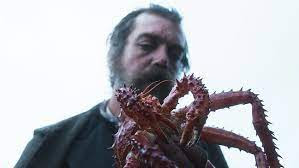 |
| Gabriele Silli and friend in The Tale of King Crab |
The first half of the film features a tragic denouement and Luciano's exile. The second half of the film commences five years later with Luciano wandering the barren archipelago of Tierra del Fuego, described in a title as "the asshole of the world". Luciano becomes embroiled, with a band of brigands, in a search for gold buried after the wreck of a Spanish galleon. Relations between individuals are barbed and querulous, as in the film's first half, and blood is again spilled. Luciano is left with the realization that gold is not the true treasure, but nature's fecundity.
This is a period picture with grit. Fingernails are filthy and feet mud caked. Yet, the film also boasts magnificent landscapes and exactly chosen compositions. The camera is usually static, but the directorial duo milks their camera set-ups for all they are worth. When Emma's father spies her and her lover blissfully lolling in the basin of a waterfall, the shots emphasize the lofty remove of the pater from the romantic duo. This not only stresses the father's stern judgement about the union, but also his elder remove from romantic passion.
In interior shots, available lighting is stressed, with, often, only a single source of light: reminiscent of Caravaggio. They punctuate a realistic narrative with moments of operatic intensity. The rhythmic minimalistic score by Vittorio Giampetro is interspersed with traditional songs (and one aria) arranged by the composer and performed by the cast. The songs offer a wistful counterpoint to the melodramatic torments of the narrative. The film contains so many riches that it overflowed my critical cup. Viewers with access to the Kanopy streaming service, free with most library cards, are strongly urged to give it a gander.





No comments:
Post a Comment